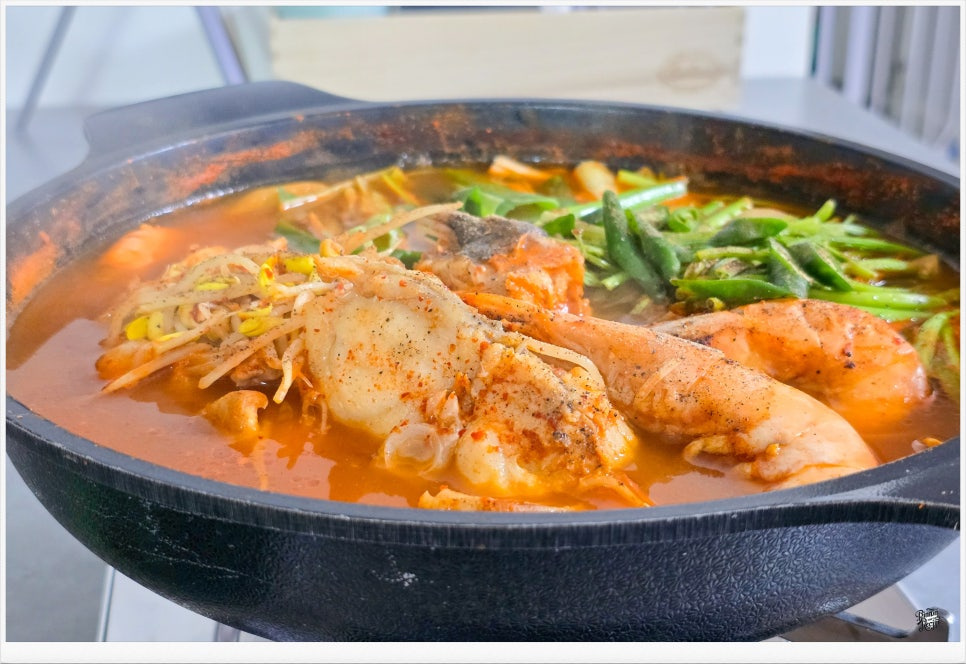Spicy and Refreshing Monkfish Stew (Agujjim)
How to Make Delicious Monkfish Stew: A Recipe for a Refreshing Broth Using Fresh Monkfish and Basic Vegetables

Discover how to easily make monkfish stew at home! With fresh monkfish, a few vegetables, and a super simple seasoning paste, you can whip up a hearty and refreshing stew in no time. Enjoy a satisfying meal on a chilly day with this spicy and deeply flavorful monkfish stew!
Ingredients- 1.5L water
- 1/4 Korean radish (thinly sliced)
- 1kg prepared monkfish (cut into bite-sized pieces)
- 1 bag soybean sprouts
- 1 handful crown daisy (minari)
- 2 Cheongyang chili peppers (or other hot peppers)
- 1-2 cube broth stock (optional)
- 2 Tbsp rice wine or soju
- 2.5 Tbsp red pepper flakes (gochugaru)
- 1 Tbsp minced garlic
- 1.5 Tbsp soy sauce or salt (adjust to taste)
- Pinch of MSG or salt (for seasoning adjustment)
- Pinch of black pepper (optional)
- 2 Tbsp sesame oil (optional, for authentic taste)
Cooking Instructions
Step 1
First, let’s prepare the base broth for the monkfish stew and get the vegetables ready. Pour 1.5L of water into a pot and add the thinly sliced Korean radish. Simmer for about 10 minutes to extract the radish’s refreshing flavor. You can also add 1-2 cube broth stocks at this stage for a deeper umami taste (optional).

Step 2
While the radish is simmering, prepare the other ingredients. Cut the crown daisy and green onions into appropriate lengths (about 5cm), and thinly slice the Cheongyang chili peppers. If your monkfish pieces are large, cut them into bite-sized portions. If using frozen monkfish, thaw it thoroughly under cold running water.

Step 3
Once the broth is boiling, remove the radish. Add 2 Tbsp of rice wine or soju to help eliminate any fishy odors (optional). When adding the monkfish, make sure the pieces are not too large to fit inside the pot with the lid. It’s common to add the monkfish first, then the soybean sprouts and other vegetables.

Step 4
It’s best to use plenty of broth initially, as it will reduce during cooking, making it easier to season. If you feel the broth is insufficient, you can scoop out some of the simmering broth into a separate bowl to use later for adjusting the taste. Generously pile the soybean sprouts on top. The crunchy texture of the sprouts will enhance the overall flavor of the stew.

Step 5
Let’s make the seasoning paste! Combine 2.5 Tbsp red pepper flakes, 1 Tbsp minced garlic, and 1.5 Tbsp soy sauce or salt in a bowl. Mix well. If the paste is too thick, ladle in a bit of the simmering stew broth to achieve the right consistency. (Tip: You can adjust this seasoning ratio based on your preference and other monkfish stew recipes.)

Step 6
Spoon about 2/3 of the prepared seasoning paste over the soybean sprouts. It’s advisable to add only two-thirds initially and then taste later to add more if needed, as it can become too salty. For a richer stew, feel free to add seafood like shrimp, sea squirts (mideodeok), or clams.

Step 7
Now, cover the pot and simmer over medium-low heat for about 5-7 minutes, or until the soybean sprouts are just wilted. Be careful not to overcook, as the sprouts can become mushy.

Step 8
Lift the lid and skim off any foam that has accumulated during cooking for a cleaner, clearer broth. It’s good practice to skim off foam periodically. Now, taste the broth and adjust the seasoning with salt or soy sauce as needed.

Step 9
Finally, add the sliced Cheongyang chili peppers, crown daisy, and green onions. Simmer briefly. A pinch of black pepper can be added for extra aroma, if desired.

Step 10
This completes the spicy monkfish stew! If you’re aiming for the slightly sweet and deep flavor reminiscent of your mother’s cooking from childhood, stir in 2 Tbsp of sesame oil at the end and simmer for another moment. The nutty aroma of the sesame oil will add a smoother, richer taste to your stew. (Adjust sesame oil to your preference.)

Step 11
Monkfish stew is delicious with rice and also makes a great accompaniment to drinks. The combination of the hot, refreshing broth and tender monkfish is superb, so why not try making it for dinner tonight!

Step 12
While ‘Agwi’ and ‘Agu’ are sometimes used interchangeably, the standard Korean term is ‘Agwi’. ‘Agu’ is a dialect term from the Gyeongsang region. The style and taste of monkfish stew can vary slightly by region. Use this recipe as a base and create your own special monkfish stew!

Step 13
The deep and refreshing broth of monkfish stew has a unique charm unlike any other spicy stew. It’s the perfect pairing with a glass of soju on a cold day.

Step 14
Tip for enjoying delicious monkfish stew! It’s important to taste and adjust the seasoning while it’s cooking. If it’s too bland, add salt or soy sauce. If it’s too salty, add a bit more water or broth. Enjoy the delightful combination of crisp soybean sprouts and tender monkfish flesh!




